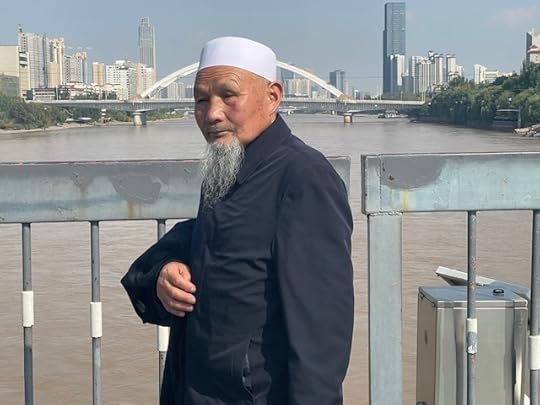Lijia Zhang's Blog, page 2
November 6, 2025
All Quiet on the Western Front
All Quiet on the Western Front by Erich Maria Remarque
I am slowly making my way through all the classics I promised myself to read before I kick the bucket. I am absolutely delighted to have read this powerful book, which shows the brutality of war from the perspective of an ordinary soldier.
All Quiet on the Western Front follows Paul Bäumer, a young German soldier who enlists in World War I with his classmates after being inspired by patriotic school propaganda. Once at the front, they quickly discover that war is not glorious at all, but brutal, random, and dehumanising.
Paul and his fellow soldiers endure bombardments, gas attacks, hunger, and constant fear. They lose their closest friends one by one. Paul becomes emotionally numb as he watches his generation destroyed physically and psychologically.
Near the end of the novel, his last surviving friends are killed. Finally, Paul himself dies on an unusually quiet day, with the army report noting only that “all quiet on the Western Front.” His face appears peaceful, as if relieved that the war is finally over for him.
The reading is not entirely bleak. There are the deep bonds between comrades, the warmth of family (his mother makes his favourite jam cakes), and joyful moments, such as catching and roasting a goose.
The author never explicitly states an anti-war position. Instead, he simply tells the truth about war. And the truth speaks for itself. I find the book painfully timely: there are still so many wars and conflicts around the world. I would recommend leaders such as Putin and Xi read this.
November 5, 2025
No country for old men
No Country for Old Men
When American writer Cormac McCarthy, author of No Country for Old Men, passed away in June 2023, I felt compelled to finally read the novel.
Set in the stark landscape of 1980s Texas, it opens with a drug deal gone wrong: bodies scattered across the desert, a truck loaded with heroin, and a satchel holding $2.4 million.
From this grim tableau emerges the novel’s three central figures: Llewelyn Moss, a Vietnam veteran who chances upon the money and cannot resist taking it; Anton Chigurh, a methodical, near-mythic hitman sent to reclaim it; and Sheriff Ed Tom Bell, an aging lawman trying, almost helplessly, to shield Moss and make sense of the violence unraveling in his county.
Moss runs, and Chigurh hunts. Along the way, the hitman leaves a trail of bodies. Despite Moss’s grit and resourcefulness, he is eventually killed off-page by Mexican drug runners. Chigurh recovers the money, survives a violent car crash, and disappears once more into the night.
The novel closes with Sheriff Bell’s retirement. In his final dream, his father rides ahead of him through the darkness, carrying a fire, a symbol of hope, I guess.
Beneath the thriller’s momentum lies a meditation on fate, free will, and the moral erosion of America. Much of the book is told in the third person, with spare, unadorned prose, but McCarthy inserts brief first-person reflections from Sheriff Bell, lyrical, mournful passages that deepen the novel’s sense of loss and bewilderment.
I found the book utterly compelling: taut, unsentimental, yet haunting. It reads like a thriller, but its power lies in the darkness beneath, and in that final, fragile image of a small fire held against the darkness.
A royal city in Nepal
Bhaktapur, also known as Bhadgaon or the “City of Devotees,” is one of the three ancient royal cities of the Kathmandu Valley. Once the capital of the Malla kingdom until the 15th century, it is renowned for its exceptionally well-preserved medieval urban layout, traditional Newari culture, and exquisite craftsmanship in wood, stone, and bronze.
While in Kathmandu, my great friend Gillian—the birthday queen—organised an outing to Bhaktapur, about 15 km east of the capital. Unlike Kathmandu or Patan, Bhaktapur retains a quieter, less modernised atmosphere, giving visitors the feeling of stepping back in time. The city is now a UNESCO World Heritage Site. It was such a joy to wander through its many courtyards and admire extraordinary buildings, such as Nyatapola Temple, the tallest and most iconic pagoda-style temple in Nepal (see second picture), or to watch craftsmen at work.
After the tour, we enjoyed an incredible tasting menu—already described in an earlier post. Bhaktapur was truly one of the highlights of the trip.
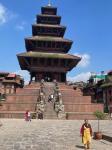
October 21, 2025
A holy cremation site
Pashupatinath Temple
Many have heard of Varanasi, one of India’s holiest cities, where devotees bathe in the Ganges River and cremate their dead. Less renowned but equally sacred, Pashupatinath Temple in Kathmandu stands on the banks of the Bagmati River, a tributary of the Ganges. It’s often compared with Varanasi because both are holy Hindu sites centered around rivers and cremation rituals.
This morning I visited Pashupatinath, a UNESCO World Heritage Site on the eastern outskirts of Kathmandu. What an unforgettable experience.
Bodies were being burned on stone ghats along the river. Ritual fires, chanting, and the wails of grieving relatives filled the air, creating a solemn, almost otherworldly atmosphere. Processions wound through the temple grounds to the beat of loud music. Sadhus, Hindu holy men in bright robes and painted faces, wandered about, offering blessings. Monkeys darted between visitors, snatching at food. It was vivid, raw, and overwhelming.
A place like Pashupatinath, or Varanasi, confronts you with death at close range. And in doing so, it forces you to reflect on how you want to live.

October 20, 2025
Buffet in Bhutan
Buffet in Bhutan
My last day in Bhutan.
I’ve loved every minute of my stay here. But if I had to name one downside, it would be the food, or, to be more precise, the buffet. Like just about every other visitor, I had to eat my meals at the hotel: not real food, but buffet food. For goodness’ sake, buffet? Even with the finest ingredients, it’s hard to get a truly decent meal that way.
I’m not even sure those dishes are what local people actually eat. It feels like a confused compromise—the worst of both worlds—between local and Western cuisines. And when we were out and about, we were taken to restaurants for lunch. Guess what? Bloody buffet again.
To make matters slightly worse, it seems tour guides aren’t encouraged to eat with their clients. They usually disappear to some hidden corner for their own meals. Occasionally, upon my insistence, my guide Tandin, ever so sweet and caring, would join me. Mostly, though, I ate on my own. It wasn’t a big deal, but it didn’t have to be that way.
Finally, I asked to eat at a local restaurant or, better yet, in someone’s home. And today, for lunch, Tandin arranged for us to visit a farm where the owner runs a small homestay. It turned out far better than I expected.
The food was easily the best I’ve had in Bhutan. In the center of the table sat a yak dish, a special treat, even for locals in lower-altitude areas like Paro. The pumpkin soup, cooked in a rich meaty broth, was delicious, and the chili in cheese sauce was also memorable.
But it wasn’t just the food. Visiting a local home gave me a glimpse of real life. Before lunch, we sat in the kitchen sipping yak butter tea, chatting with the hosts as the fire crackled in the stove.
It happened to be Tsechu, a religious festival associated with Guru Rinpoche—the one who, legend has it, flew to Bhutan on the back of a tigress. Each district celebrates it on a different date. When we arrived, the family was busy preparing for the evening’s communal feast, laying offerings before the household altar. Young monks were practicing on long Tibetan trumpets. Later, there would be masked dances, singing, and merrymaking.
This was exactly the kind of experience I’d been craving, not staring out from a hotel window and eating yet another bloody buffet.
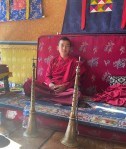
October 18, 2025
The fertility symbol in Bhutan
The Fertility Symbol and the Mad Monk
This post is not for the faint-hearted. Consider yourself warned.
One of the most striking — and frankly, hilarious — symbols visitors encounter in Bhutan is the phallus. Yes, that phallus. It’s boldly painted on house walls, displayed in temples, hanging from eaves, or carved into wooden charms. There’s even one in my hotel room. Far from being obscene, this proudly displayed symbol of fertility is tied to the legend of a very colorful figure: Drukpa Kunley, also known as the Divine Madman.
Today, we visited Chimi Lhakhang, the temple dedicated to him, in Punakha in central Bhutan.
Drukpa Kunley (1455–1529) was a Tibetan monk, poet, and tantric master with a teaching style that can best be described as… unorthodox. While other monks followed strict rituals, Kunley preferred humor, shock tactics, and the occasional scandalous gesture to cut through ego and hypocrisy. He wandered through Bhutan and Tibet singing bawdy songs, cracking jokes, and generally behaving in ways that would give most abbots a heart attack.
Unlike many pious teachers, he didn’t view sexuality as shameful — he saw it as natural and divine. Good on him.
According to legend, he used his penis — which he affectionately called his “Thunderbolt of Flaming Wisdom” to subdue demons and bless women who came to him seeking fertility. Over time, the phallus became a symbol of fertility and protection, believed to ward off evil spirits and bring good fortune.
These days, the shops around the temple are a phallic wonderland. Painted, carved, polished, dangly — they come in every size and color imaginable. No one’s blushing; everyone’s laughing.
Even today, Bhutanese people, especially in rural areas, paint large, colorful phalluses on their homes or hang wooden ones at the entrance. In Bhutan, it’s not rude. It’s lucky. And since I’ve been blessed by so many phalluses, dare I hope I’m now fully 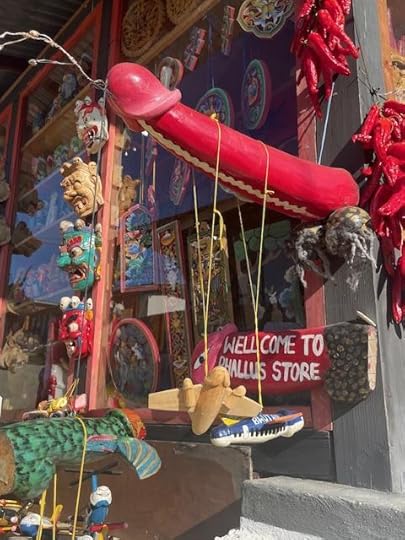
protected — and blessed?
October 16, 2025
The fortress turned government seat
Tashichho Dzong — the Grand Fortress of Thimphu
This majestic fortress and monastery stands proudly on the banks of the Wang Chhu River in Thimphu. First built in 1641 by Zhabdrung Ngawang Namgyal, the unifier of Bhutan, it has long been the heart of the country’s political and spiritual life. In the 1960s, the third king, Jigme Dorji Wangchuck—often called the father of modern Bhutan—renovated the dzong, turning it into the seat of government while preserving its distinctive Bhutanese architecture.
Today, it houses the Throne Room and the King’s offices, key ministries, and serves as the summer residence of the Central Monastic Body. This unique blend of history, political power, and spiritual significance makes it one of Bhutan’s most iconic landmarks.
The dzong is a stunning example of traditional Bhutanese design, with whitewashed walls, golden roofs that shimmer in the sun, elaborately carved woodwork, and wide courtyards.
Because it remains an active seat of power, visitors are only allowed to enter in the late afternoon, after government officials finish their work for the day.
Wandering through the spacious courtyard was a delight. Beyond the richly decorated temple interiors, I loved simply standing in the open air, watching the monks go about their daily routines—turning prayer wheels, sweeping the grounds, chatting softly. So far, this fortress is, without question, my favorite site in Bhutan.
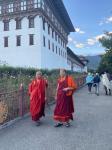

October 9, 2025
Fine dining in Nepal
Tasting Menu in Kathmandu
I’ve had my fair share of tasting menus in this life, from solemnly plated morsels in Paris to architectural salads in New York. But I confess I did not expect to encounter such refined culinary delights in Nepal.
Today, Gillian — birthday queen and the reason I’m here — organized a celebratory dinner at what may well be the best restaurant in Kathmandu, if not the entire country. The banquet began in Bhaktapur, a beautifully preserved medieval city about 13 km east of the capital, famous for its temples and elegant Newar architecture.
After sightseeing, we were whisked to a restaurant with the most auspicious of names: Tusa, meaning “new beginning.” A welcome drink awaited us — cucumber juice with mint and some mysterious “other goodies” (avocado? fairy dust?). Whatever it was, it was fresh and dangerously good. My appetite perked up like a hungry fox.
Then came the eight-course feast. First: warm buckwheat bread tucked prettily inside a hand-painted wooden box, accompanied by herb-infused butter that could make ordinary butter hang its head in shame. Next, a crisp lentil fritter — imagine falafel’s more elegant cousin — crowned with a snowfall of cheese.
Then something truly exotic: Rildhuk, a traditional dumpling-like dish made from millet flour, served with earthy mushrooms and a delicate foam of gundruk. Yum. A pan-seared river fish followed, flanked by pickles and finely chopped vegetables — light, bright, and perfectly balanced.
A lemon and apple sorbet then arrived to “cleanse our palate,” though it felt more like an invitation to keep eating. The main course — roasted chicken with cauliflower purée — was nothing short of sensational. And then came dessert, plural: a parade of sweet things, the star being a cake made from stinging nettle (yes, nettle!), served with buffalo yogurt and chestnut purée. Heavenly.
We were nine in total, all gloriously stuffed, slightly giddy, and entirely content. Kathmandu had just delivered a culinary surprise with the precision of a master chef and the flair of a magician.
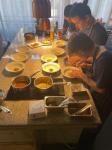
October 8, 2025
Kathmandu
Kathmandu
I was last here about 34 years ago, when my ex and I travelled overland from Lhasa. Those two months remain the best journey of my life. The final stretch in China had no public transport, so we stuck out our thumbs and hitched rides. One truck driver kindly let us on. Only later, when I got down, did I notice my backside was blood-stained. It turned out that I’d been sitting on a freshly slaughtered yak.
I also remember the delirious joy of eating in Kathmandu after Tibet. In Tibet, the landscapes and people were unforgettable; the food, not so much. Imagine a diet designed by people who think “flavor” is a dangerous foreign idea. These days, the food in Tibet is much better, thanks to Chinese influence. (I know this is a loaded statement!)
Arriving in Kathmandu, I ate like a woman possessed, demolishing momos, curries, sushi and anything else put in front of me.
Now, decades later, I’m back. I’m once again eating my way through the city, occasionally pausing to explore and walk around —just enough to make room for the next meal. Here are a few random shots before I roll myself to the next restaurant.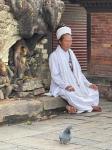
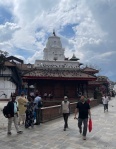

October 7, 2025
Lanzhou
Lanzhou
Lanzhou, the capital of Gansu province, probably doesn’t rank high on most tourist itineraries, but I have to say it turned out to be a delightful city. After sampling the famous food street, we – my daughters and I – strolled across the Zhongshan Bridge, proudly known as the “First Bridge of the Yellow River”, the very first permanent crossing ever built over China’s mother river. From there we wandered into the riverside park, which was bursting with life.
The whole place was alive with music and movement. Elderly people waltzed under the trees, groups of women lined up for the familiar square dance, while another circle swayed and spun to Uygur melodies. Some had even gone the extra mile, dressing in brightly colored Uygur outfits, sequined vests and embroidered headscarves flashing in the sun.
I am no dancer, but the sheer joy of it was infectious. Before long I found myself muddling along, arms waving vaguely in time with the music. No one minded my clumsy steps. Everyone was too busy laughing, clapping, and spinning. What fun it was to be swept up in such unselfconscious happiness, right on the banks of the Yellow River.